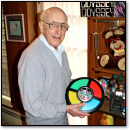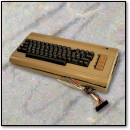Archive for the 'Retro Scan of the Week' Category
[ Retro Scan of the Week ] Grolier’s Encyclopedia on CompuServe
Monday, August 23rd, 2010For my sixth grade social studies class, I wrote a report on Mikhail Gorbachev, former President of the Soviet Union. And he really was “former” then — the USSR had fallen apart just two years prior to my report in 1991. For that report — which I ran across recently — I used every resource available to me, including a novel one at the time: Grolier’s Encyclopedia on CompuServe Information Service. My family subscribed to CompuServe — that massive, pre-ubiquitous-Internet dial-up service that cost amazingly large fees an hour — and I loved it.
What you see above is part of the Gorbachev encyclopedia entry in the form of a dot-matrix printout from the DOS version of CompuServe Information Manager (a front-end client for CompuServe) that I printed myself. Various lines are crossed out and underlined, noting areas of interest that I was to paraphrase for the report. This wasn’t plagiarism — I even cited the online encyclopedia in my report’s bibliography. That fact is actually kinda impressive to me in retrospect.
CompuServe’s online encyclopedia was amazing at the time (1992-1993 era). It was so easy to just search for a term, look it up, and print it out. It sure beat our family’s musty 1968 World Book Encyclopedia set that I used for every report prior to this one (yes, the information in my reports was often woefully out of date). For Christmas 1993, my dad bought us Microsoft Encarta on CD-ROM, and that served as the meat of my school reports for the next few years after that. But that’s another story entirely.
Discussion Topic of the Week: When did you first use an electronic encyclopedia — CD-ROM or otherwise? What did you use it for?
[ Retro Scan of the Week ] Quake II Meat Market
Monday, August 16th, 2010 “Hand-cranked and chock full of juicy new tidbits.
“Hand-cranked and chock full of juicy new tidbits.
All stuffed into authentic id Software casing.”
Quake II will be 13 years old this December — has it been that long already? Seen here is a 1999 advertisement from EGM promoting the PlayStation and Nintendo 64 ports of the classic PC shooter. The designers of the ad chose a clever theme that parodies a grocery store circular (commonly inserted into newspapers here in the US), complete with a fake coupon and flashy pricing. Very clever, and very effective.
Discussion Topic of the Week: Let’s talk Quake. Best game console version of Quake? How about Quake II?
[ Retro Scan of the Week ] All Hail Bob, Destroyer of Worlds
Monday, August 9th, 2010 The pagan god manifests in many forms, demanding a tribute of small children.
The pagan god manifests in many forms, demanding a tribute of small children.
This image is part of a two-page double-sided fold out ad attached to the back cover of Home PC magazine. Its main subject was not actually Microsoft Bob, but a Micron P75 PC (click there to see that page).
Microsoft designed Bob (1995) to serve as a friendly graphical interface and operating environment for beginners, but the product flopped mightily and has since become a tech punchline.
Speaking of Bob, my buddy Harry McCracken has written more about Microsoft Bob than any other living human being on the planet. A good place to start would be his Bob Chronicles, which talks about the origins and history of Bob.
Discussion Topic of the Week: Have you ever used Microsoft Bob? What did you think about it?
[ Retro Scan of the Week ] ASG Video Jukebox
Monday, August 2nd, 2010 “ASG: Eating the Rules” (It really says that.)
“ASG: Eating the Rules” (It really says that.)
Rack and stack, Jack! This totally radical ASG Video Jukebox allowed you to play six of the Sega Genesis games you already owned for only $49.99. Imagine finally being able to play those games you bought without having to insert and remove them from the system every time. Imagine.
The problem with this device was one of scale. If you had only six carts to choose from, it’s wasn’t worth buying a jukebox device to let you switch between them quickly: keeping track of six cartridges was easy. The ad says you could chain up to six of these jukeboxes together for a total on-line selection of 36 carts. By that point you were looking at a $300 investment in gadgets that weren’t actually that useful.
On the other hand, if you had a device that let you switch between 100, 200, or 500 carts at once, that would have been legitimately handy. But the device would have cost $1000 and nobody owned that many carts back then anyway. Today, we have the same functionality in the form of emulator software, so lazy Genesis fans have long since been appeased.
If anybody actually bought one of these, I’d be interested to know about it.
Discussion Topic of the Week: How many Sega Genesis cartridges do you own? How many did you own in 1994?
[ Retro Scan of the Week ] The Whole Dam Thing
Monday, July 26th, 2010 The Portrait Display Labs Pivot 1700
The Portrait Display Labs Pivot 1700
When I was a kid, I found myself wondering why all monitors didn’t rotate from a horizontal to a vertical orientation. I thought I had invented the idea myself. Turns out, at least one company actually did make a monitor like that — the Pivot 1700 — and you’re looking at it now.
Full-page displays were something of a marketing fad during the rise of the desktop publishing revolution from the mid-1980s to early 1990s. They were designed with a vertical orientation so that someone could read or edit a full 8.5″ x 11″ letter-sized page on screen at one time.
I have no doubt those displays came in handy for certain document designers and secretaries, but their high price and specialized function limited them to a small market. To this day I have never seen one being used in the wild, although I have encountered a few full page displays out of service in my collecting adventures.
In more recent years, I’ve seen some LCD monitors that can rotate on their base to change orientations rather easily. There’s no doubt that it’s a much easier trick to pull off considering the small size and weight of LCD panels verses their bulky CRT counterparts. Now whether anybody needs it or not with today’s super high resolultion 30″ displays, I don’t know.
Discussion Topic of the Week: What’s the largest CRT computer monitor you’ve ever used? How big is your monitor (any kind) now?
[ Retro Scan of the Week ] Road Rash 64
Monday, July 19th, 2010[ Retro Scan Special ] IBM Taught Me How to Read
Sunday, July 11th, 2010Periodically, I visit my parents’ house and pick through the material vestiges of my childhood. Old toys, broken knickknacks, and drawings rendered in crayon litter their dusty attic. My mom, being the mother she was, tucked them away as small monuments to her child’s journey through life. I’m happy she did.
During one of these visits in 2008, I ran across this curious artifact of my early education. It’s one of my kindergarten spelling workbooks, still filled out in my meandering 5-year old hand all these years later.


As I flipped through its pages, memories of my kindergarten year — 1986 — began to bubble up from the deepest corners of my brain. I remembered the workbook’s contents surprisingly well: it contained simple words with letters omitted, replaced with blanks in which I scrawled awkward glyphs.
I recalled having my spelling knowledge put to the test on primitive PCs of the day, which I had always assumed were Apple IIs in retrospect. But when my eyes fell upon the famous IBM logo printed on the cover, a strange realization washed over me: IBM taught me how to read.
[ Continue reading [ Retro Scan Special ] IBM Taught Me How to Read » ]
[ Retro Scan of the Week ] Rampant Inflation
Monday, July 5th, 2010[ Retro Scan of the Week ] Paul Revere’s Midnight Modem
Monday, June 28th, 2010 Apparently Paul Revere owned a secret power plant in 1775.
Apparently Paul Revere owned a secret power plant in 1775.
Discussion Topic of the Week: How fast was your first modem? What year did you get it?










